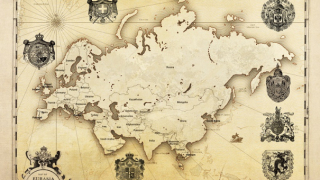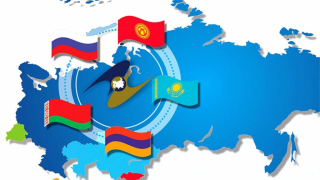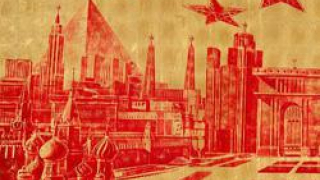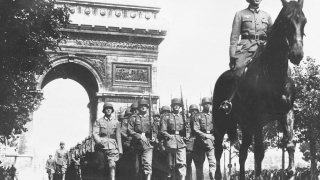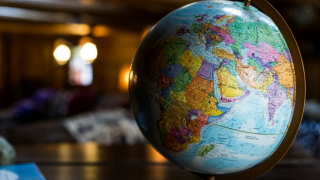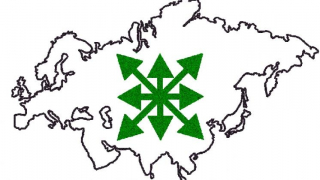Whither Germany – East or West?
This past October 3rd marked the twenty-fifth anniversary of the “reunification” – or rather, Atlanticization – of the German fatherland. Of course the mainstream media outlets in Western Europe and the United States were all too eager to cover the event as a celebration of so-called Western “democratic” (i.e. liberal) values over communism and “totalitarianism.” And as usual (since history is indeed written by the victors), the East German regime as well as the entire East German experience was extensively vilified in the one-sided reporting. All the serious questions, discussions and debates, which should have been raised, were conspicuously lacking throughout the continuous circus-like coverage of the BBC, CNN, DW, et al.
Two specific questions should have been directed to those who remember what it was like to live in a divided Germany. First, to the people of the former Deutsche Demokratische Republik or“DDR” (East Germany): Are you better off now than you were under socialism? And to the people of the Bundesrepublik Deutschland or “BRD” (West Germany): Twenty-five years after your liberal-bourgeois “victory” over the East, is your government any less of an American puppet regime?
I suppose the answers to both questions depend on whether or not one views the world (and everything in it) through a liberal capitalist Western lens. If one does, then the answer to both questions is a resounding “yes.” On the other hand, if one views the world in a more balanced way – which is to say organically, from a multi-civilizational, traditional, anti-liberal perspective – then the answer to both questions must be “no.”
The chief problem with the liberal interpretation of the past quarter century of German history is that it comes from a totally non-traditional source – meaning a source which is non-Germanic, non-Prussian-Socialist, non-hierarchical, non-telluric (non-continental), hence non-German. Indeed, the liberal mainstream narrative of all German history has (for the past 70 years) come directly out of the camp of the historic geopolitical enemies of the German people – i.e. from the liberal, thalassocratic (sea-based), Anglo-Saxon despoilers of Germany and the German national Idea. In other words, the mainstream German narrative has been controlled by the United States, Britain, and the veritable hordes of fifth column anti-German propaganda agents based inside West Germany and its post-1990 successor state. Whether or not the majority of Germans understand this depends on how thoroughly they have been brainwashed, especially within the last 25 years as German society has (like the broader West) burrowed deeper and deeper into the hyper-liberal abyss of postmodernity.
Of course, any geopolitical and/or cultural observer worth his weight will already know that a truly united German nation (as existed before 1945) does not exist today. Despite the past quarter-century of “reunification” propaganda (and now mythology), there are still two German states in existence – perhaps not politically, but there are still two conflicting German states of mind or being. In western Germany the liberal mindset dominates the socio-cultural-economic-political life of the people, while in eastern Germany (the former DDR) a much more conservative or traditional mindset prevails, which has kept alive the last vestiges of the unified Germany that existed from 1871 (some might even say from the time of the Holy Roman Empire) until the end of the Second World War.
As proof positive of the conservative/traditional essence of the former “communist” East Germany one must consider the fact that, all throughout the Cold War period, countless Western observers were totally mystified to see the East German people holding on to the old way of life and to more of the old German customs than the people of the Western-aligned BRD. Again, this should come as no surprise to competent scholars (particularly cultural, historical and geopolitical analysts) because traditional/anti-liberal Germany – which is to say, the German national Idea or Culture-soul in its essence – has always existed on the periphery of the Western culture and has consistently clashed with the true West whenever the latter has forcibly imposed itself on the German people. Consider the historical development of the Kingdom of Prussia on the shores of the east Baltic, so far removed from the more “refined” German towns of the west, such as Munich, Bonn, Hamburg and Cologne. And yet it was Prussia that eventually unified the German Reich; it was the peripheral eastern European Prussia that represented the values and the interests of the staunchest traditional elements within all Deutschtum. Indeed, one will find the true origin of the German Soul the further one ventures north and east into Europe.
When one delves further back into the primordial past, one will find that the German national Idea or Soul had achieved its greatest unity prior to its entrance into Roman (recorded) history, when all of the pagan Germanic tribes still lived on the icy fringes of the Baltic Sea. Yes, the purest Germanic unity (which had no need for any inorganic “reunification”) occurred long before the tribes began their descent into the Roman occupied lands of central and western Europe; long before they began their campaigns of military conquest, and long before they were spiritually conquered and “cleansed” by Rome.
The tendency in the German Soul toward dualism, toward two “German states” (as it were), had only begun to manifest itself as the Pagan period was approaching its end. It manifested itself in the internecine struggle between German pagans and German Christians, and in the subsequent struggles between Catholics and Protestants and then (at the start of the modern era) between liberals and anti-liberals. This latter struggle for the German Soul – as the least “Western” of the Western souls – continues into the postmodern era.
The liberals need no longwinded description here; we all know who they are – the chief enemies of all mankind. On the side of the anti-liberals, however, stands a diverse assortment of rival political factions from both the Right and the Left. On the Right there are the neo-Nazis, radical conservatives (à la Carl Schmitt and Arthur Moeller van den Bruck), and the folkish or rather völkisch neo-pagan elements. On the Left there are the die-hard socialists and communists. Here, it is important to understand that a great organic bond exists between the diverse ideological sects of the anti-liberal Right and Left, despite all the liberal propaganda to the contrary – propaganda which constantly hammers away, driving ever greater wedges among the ranks of the anti-liberals (or what remains of them). And indeed, liberal propaganda has largely succeeded in its task, so we must not have any illusions in this regard. The liberals have long since declared a total victory in Germany, just as they still hope to declare victory over the entire globe – and soon!
Nevertheless, anti-liberal elements (like the ones mentioned above) still exist in Germany, even if only on the margin of political life. These elements represent the last bits of hope for both the German people and the German national Idea/Soul – an Idea which has always been (among other things): telluric (land-based, continental), anti-materialist, hierarchical, agriculturally-oriented, socialistic (in terms of social justice), and thus perfectly aligned to the broader Eurasian/Russian Idea.
The task now is to consolidate the anti-liberal elements of Germany into a greater bloc or movement, which would then be in a position to seriously threaten the liberal status quo. Specifically, this means forming a coalition between German: neo-Nazis, radical conservatives, socialists/communists, and neo-pagans. An alliance must be forged between fascists and anti-fascists – between those who are currently battling each other and are thus being played for fools by the ruling Merkel-Atlanticist liberal elites.
In the author’s opinion, a firm alliance can be accomplished based on the following triple-consensus: (1) the neo-Nazis, radical conservatives and (to some degree) the neo-pagans must accept the anti-capitalist economic argument of the socialists/communists, in line with the left-wing position promoted by the late Strasser brothers (Gregor and Otto) and the more radical elements of the Sturmabteilung (SA); (2) the socialists/communists must accept the ethnic/nationalist positions of the neo-Nazis, radical conservatives and neo-pagans, in line with the beliefs of the founding members of the National Bolshevik tendency, such as Heinrich Laufenberg, Fritz Wolffheim, Ernst Niekisch and Ernst Jünger; (3) the natural/environmental consciousness of the neo-pagans must be accepted by all.
Such a compromise – or rather, consensus – can be achieved especially when taking into account the historic factor: viz. the positive historical legacy of East Germany (DDR). Indeed, it must be celebrated among all anti-liberals that for a period spanning just under half a century (brief though it was), there was a viable German state which rejected all liberal Western values and therefore, consciously or not, accepted the triple-consensus outlined above. New historical scholarship exploring alternative narratives, and from a variety of revisionist perspectives, should be encouraged among the anti-liberals. Even the alleged failures of the East German state should be reassessed and turned into (as of yet) unrecognized victories.
For example, great attention should be drawn to the fact that although the Socialist Unity Party of Germany (the governing party of the DDR) prodigiously attempted to convince the East German population of the “anti-Prussian” nature of the East German society and state, the Prussian character never wavered – indeed, it was ever present. Now is the time to celebrate the DDR and its Prussian-Socialist essence. Now is the time to consider what might have been, had the Soviet bloc nations not been collectively stabbed in the back by that brazenfaced traitor bearing the red mark of Cain on the top of his head (Gorbachev). Now is the time to also consider the many disasters which would have never occurred if the East won the Cold War instead of the West – disasters of epic proportions such as: mass immigration/demographic displacement; the immense increase in social and economic disparities (the ever widening gap between rich and poor); the extension of American economic, military, political and cultural domination over practically all of the former Soviet bloc states via the U.S. military, NATO, the EU, and the degenerate influence of the American “entertainment” industry.
And so, once there is a general consensus between Germany’s anti-liberal/anti-Atlanticist forces, a legitimate anti-liberal movement can be formed within Germany and perhaps also within the other neighboring countries of Mitteleuropa and the old Soviet bloc. The International Eurasian Movement would naturally consider such a development to be a major step forward toward the future realization of the long-forecasted and long-awaited Berlin-Moscow axis, upon which the multidimensional Eurasian State must be built – a State which does not take its “marching orders” from Washington, but is poised and ready to march against all the forces of Washingtonian aggression wherever they are found.
It is therefore essential for the International Eurasian Movement to support all of the anti-liberal/anti-Atlanticist forces in Germany. Special attention must be given to Germany’s Eurasian/Nazbol heritage by promoting the works of suchtwentieth century men of vision as Ernst Niekisch and Ernst Jünger. Germany’s anti-Western folkish heritage – which is to say, the country’s deepest indigenous roots – must also be promoted by supporting the positive spiritual, ethnic, cultural, social and ecological super-agenda of the neo-pagans.
At the same time, attention must be drawn to the vast and irreconcilable differences separating the Anglo-Saxon worldview (which is fundamentally liberal, individualistic, capitalist, anti-social and anti-traditional) from the German/Germanic worldview (which is intrinsically conservative, communitarian, social, hierarchical and traditional). The IEM must also point out the considerable differences that exist between the agricultural, nature-loving nations of Germanic Europe and the countries of Latin Europe, which are firmly based on what can rightly be described as “Guelphism” – i.e. Roman law, Catholic religious/cultural chauvinism, capitalist attitudes, and cosmopolitan values (epitomized by French hyper-egalitarianism).
As for similarities, the IEM must highlight the countless spiritual, ethnic and cultural bonds which exist between Germanic and Slavic Europe – bonds which are too often ignored due to the short-sighted desires of petty nationalists on both sides. The IEM must see to it that yesterday’s Pan-Germans and Pan-Slavs come together today, from the Rhine to the Amur, in service of a greater Pan-Eurasian mission which will provide a “better tomorrow” for both ethnic groupings. And indeed, the International Eurasian Movement is currently working toward the full materialization of this mission.
In the meantime, all Germans must ask themselves the following question: “Which way should we proceed geopolitically – East or West?” Surely, as the inevitable global showdown between Eurasia and Atlantica approaches “zero hour,” Germany will not be able to go both ways as it did during the Cold War. Whither Germany?


